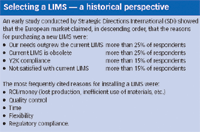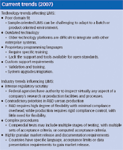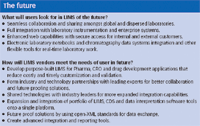20th Anniversary Special Feature: The transformation and future trends of laboratory data management
Pharmaceutical Technology Europe
Historically, the main purpose of laboratory information management systems (LIMS) has been to track and manage samples in the laboratory. LIMS originated nearly 30 years ago as a rudimentary method of automating manual, error-prone processes in the laboratory and, with the growth in adoption of technology, became the de facto benchmark for laboratory control and management.
The emergence of LIMS
Historically, the main purpose of laboratory information management systems (LIMS) has been to track and manage samples in the laboratory. LIMS originated nearly 30 years ago as a rudimentary method of automating manual, error-prone processes in the laboratory and, with the growth in adoption of technology, became the de facto benchmark for laboratory control and management.
In the early evolution of laboratory information systems as data management tools, LIMS were essentially developed in-house by scientists to satisfy a defined need. Those early LIMS were eventually brought to market by vendors to fulfil a growing need in the industry. While the emergence of LIMS sprang from the environmental industry, the pharmaceutical industry was an early adopter as a result of growing regulatory pressures; increased sample throughput; demand for more efficient management; the need to eliminate human error; and a drive for integrating data throughout the enterprise.
Evolution of pharma LIMS
LIMS were readily adopted in the pharmaceutical industry because they increasingly met industry-specific requirements, in place of organization-specific requirements. The need for organizations to comply with regulatory and manufacturing processes such as cGMP, NAMAS (National Accredititation of Measuring and Sampling), Environmental Protection Agency (EPA), FDA and GLP/GALP was a driving factor in the pharmaceutical industry's early acceptance of LIMS.

Selecting a LIMS - a historical perspective
However, with time many early users were left with heavily customized legacy systems that proved difficult to upgrade and integrate with other business functions. As the industry itself changed, and merger and acquisition (M&A) activity altered the pharmaceutical landscape, application integration became a necessity to ensure that laboratories made their data accessible throughout the enterprise. After 10–15 years, homegrown legacy systems had become almost obsolete — replaced by more available, upgradeable and compliant vendor-supplied generic LIMS. These early systems, while designed to provide basic data management and meet regulatory compliance, required a high degree of customization to meet the specific needs of each particular user group across the enterprise. LIMS were not customarily designed to operate at full functionality, which required pharma users at the research, development or manufacturing phase of drug development to 'customize' the LIMS for that particular laboratory application with its specific workflow and data management requirements.
Past technology trends
Technology has played an important role in the changing face of LIMS. In-house LIMS were typically based on simple spreadsheet packages, while vendor-developed LIMS were frequently modelled on minicomputer platforms, such as Digital's VAX running the VMS or UNIX operating systems. These LIMS had the advantage of being multiuser, secure and centrally administered. Increasingly, business rules such as operator approvals, test schedules, templates and the core database became centralized server-based activities. Against this background ran the contra-argument for PC-based integrator systems, which claimed that support costs for minicomputers and associated software were more costly.
PC-based solutions were then based on the basic Windows platform on top of a DOS operating system. Disadvantages were lack of security, the need to copy methods onto all machines individually rather than centrally when alterations were required, and a relative lack of processing power (PCs were costly 10 years ago, and so inevitably many organizations consigned their slowest PCs to the task of laboratory data collection and analysis — which up to that point had been done manually).
The overwhelming adoption of Windows as a common platform in the 1990s led to a global scrutiny of legacy systems within the laboratory. Microsoft Windows NT was seen to bridge server-based networked system environments and the standalone PC desktop environment. Migration to Windows NT as a corporate standard precipitated the need for NT-based LIMS, offering a reliable, secure and stable environment for data. The NT-platform was seen as a coming-of-age for LIMS, and a natural upgrade path for laboratories operating either on legacy systems or on IBM-compatible PCs.

Current trends (2007)
Equally, wider use of the internet in the late 1990s — such as in field research where most access to information was through the web — affected the way in which scientists considered the management of, and access to, their data.
To summarize, the growth in the supporting technologies has allowed LIMS to grow in scope with time — from single-user desktop tools to global, enterprise-wide critical business applications.
Limitations of generic LIMS: one size does not fit all
As previously discussed, LIMS were initially developed to address information gathering and processing needs in environmental laboratories. As the similarities between laboratories in different industries became more obvious, LIMS vendors focused on developing highly adaptable generic systems that could suit various industry requirements. These solutions were provided with customization tools designed to extend the systems' capabilities to meet end-user needs. Customizations were very expensive, timely and resource-intensive as they required specialized IT experts skilled in programming languages. Systems were typically sample oriented and common functionality included sample registration and management, test results, specification checking and user security.
The objective of the LIMS vendor has traditionally been to promote and sell one system into any laboratory, regardless of the industry. However, this approach did not work for the pharmaceutical industry as laboratories in this field require extensive customization of a generic LIMS to meet the unique requirements of contract research organization (CROs), drug discovery, preclinical, clinical, research and manufacturing laboratories.
Pharma reality: the perpetual functional gap
The reality for the various types of laboratories in the pharmaceutical industry is that generic LIMS typically satisfy only 30–40% of their needs. Deployments take an average of 18 months, but can take as long as 3 years. In addition, system requirements are certain to change during these time frames. The result: a 'perpetual functional gap' between what the LIMS can deliver and what the laboratory requires. To close this gap and support their legacy systems, organizations must incur the costly and timely effort of customizing their LIMS. The need for internal expertise and resources to maintain, enhance, train and validate custom code is far from a pharma company's core competency.
In addition, today's organizations are looking to their LIMS to take on the more strategic role of harmonizing and standardizing their global laboratory processes. In many cases, M&As have led to heterogeneous environments that are costly and ineffective. By unifying these documents and rules, LIMS are now becoming the corporate standard. The ineffectiveness of generic LIMS is even more evident in the pharmaceutical industry when it comes to government regulations — in particular, the International Conference on Harmonization (ICH) guidelines. Once again, organizations are looking to their LIMS to assist with regulatory harmonization by building this functionality into them.
Today's solution: purpose-built LIMS for the pharmaceutical value chain
The result of these technologies and market trends, coupled with the strict regulatory requirements governing the complex operation of pharmaceutical laboratories, has forced the industry to look for more purpose-specific solutions that no longer require 'customization', but can be 'configured', reducing the exorbitant deployment, validation, and maintenance burdens. Because of the intensive and costly burden pharmaceutical companies must incur, it is important for organizations to understand the difference between these terms and key considerations when selecting a LIMS system.

The future
Purpose-built solutions with rich industry-specific functionality already incorporated into the base product ensure that companies do not need to go through costly, timely and risky customizations. Solutions must be built on open standards and services oriented architecture (SOA) that are designed to be quickly and easily implemented. By providing purpose-built LIMS solutions for specific applications in the pharmaceutical industry that are married to horizontal integration technologies, vendors can provide a holistic view across the entire drug development life cycle, while still allowing fast implementation and adoption times for each of the solutions.
This is of particular importance for the pharmaceutical industry because LIMS capabilities and functionality for drug discovery, research, clinical trial management and manufacturing are all vastly different. For example, the limitations of generic LIMS versus purpose-built solutions for pharmaceutical manufacturing R&D and QA/QC can serve as excellent indicators of a vendor's real capability to deliver a truly configurable solution. In addition to the changing requirements as a drug moves through its life cycle, there is also the nature of the drug itself to consider. As pharmaceutical companies broaden their focus from exclusively small molecules to include biologics, it is important to select a LIMS capable of handling both in a single environment. A true purpose-built LIMS will be optimized for a wide range of manufacturing processes; from tablet manufacture to fermentation.
In drug discovery and research, a purpose-built LIMS will need to be flexible enough for changing environments, but also able to handle the nuances of increasing sample throughput, servicing external clients and managing clinical studies. Distinct LIMS with these capabilities built into the base of the product ease implementations, validation and training, while generic LIMS that require heavy customization to automate a specific business process can lead to cost overruns, complexity and commitment to ongoing maintenance — issues that resurrect themselves with each system upgrade.
Future trends
To see where the LIMS industry is moving, we need to look at the unanswered challenges of pharmaceutical companies today. The industry as a whole is struggling to bring more products to market, despite significant increases to the money spent on R&D. Many pharmaceutical and biotech companies recognize that, to be successful in moving forward, they must facilitate collaboration between scientists to minimize rework and, more importantly, ensure that scientists have the information they need to make the right decisions. This is increasingly important as pharmaceutical companies continue to expand their operations globally.
The future role of informatics is to provide scientists with this information located across the enterprise, both as structured and unstructured data. LIMS can help remote scientists to truly collaborate and make better, more informed decisions, which results in considerably increased laboratory productivity. Laboratories are generating increasing amounts of data as analytical techniques become more sophisticated, and this means there is greater pressure on them to automate and integrate systems to make use of the additional data. LIMS are key to the enablement of automation, data sharing, collaboration and integration across multiple data sources and products, both hardware and software. Forward thinking LIMS vendors must form partnerships with software vendors, such as Microsoft and Oracle, to ensure that information sharing through LIMS will be enabled on a global scale across multiple locations and disciplines.
Where is Thermo Fisher Scientific moving in the longer term? We are focusing our energy on providing pharmaceutical companies with ways to work more effectively with their colleagues. Social networking is a reality and we need to facilitate the productivity and collaboration that can come from it. Part of the reason for reaching our current position is informatics systems, such as LIMS, electronic laboratory notebooks and chromatography data systems, born out of feature sets instead of focusing on the laboratory workflow and the flow of information throughout the drug development life cycle. For informatics companies to be successful, they must partner with pharmaceutical companies to better facilitate information sharing and collaboration across the entire enterprise. In the future, we will see an increased blurring of the lines between the traditionally siloed applications. The pressure to operate and collaborate more efficiently, coupled with technology advances, such as SOAs, will move the industry in a direction where holistic interfaces and seamless workflows are supported by interoperable, nearly plug-and-play services. Further evolution of mobile computing infrastructure, along with regulatory acceptance of initiatives such as process analytical technology (PAT) will also drive greater collaboration between the LIMS and manufacturing, allowing more efficient real-time, in-process evaluation of products.
To meet the evolving needs of pharmaceutical companies, LIMS will need to grow in terms of what they offer in out-of-the box functionality, breadth of interconnectivity and extent of collaboration. Along with other business-critical applications, LIMS will need to be able to plug into a more seamless enterprise that allows users to work more efficiently and at a higher level. As with previous advances, LIMS will grow in scope to meet an even greater level of laboratory need, allowing its users to increasingly focus on the bigger picture.
Bibliography
1. www.fda.gov
2. FDA Guidance for Industry: Good Laboratory Practice www.fda.gov
3. Current Good Manufacturing Practice www.gmp1st.com
4. www.strategic-directions.com
5. National Accreditation of Measuring and Sampling (UK) – Now known as UKAS. www.ukas.org
Dave Leitham is director, products, at Thermo Fisher Scientific. He joined Informatics when Thermo Fisher acquired InnaPhase Corporation in September 2004. As the director of products, Dave orchestrates the multinational team that engineers and product manages the informatics solutions offered by Thermo Fisher. His career spans 16 years of software development expertise, much of which has been focused on developing high quality scientific and commercial software.
Trish Meeks is director of product strategy, life sciences at Thermo Fisher Scientific. She joined informatics when Thermo Fisher acquired Thru-Put Systems Inc. in June 1999. As director of products strategy, life sciences, Trish is responsible for determining the strategy of Thermo Fisher's current portfolio while identifying new market opportunities within the life sciences. She has worked for Thermo Fisher for the past 9 years in the development, sale, support, and marketing of laboratory software. A graduate of Loyola University with a BS in Chemistry, Trish began her career performing environmental analysis and chemical vapor deposition research.

Drug Solutions Podcast: A Closer Look at mRNA in Oncology and Vaccines
April 30th 2024In this episode fo the Drug Solutions Podcast, etherna’s vice-president of Technology and Innovation, Stefaan De Koker, discusses the merits and challenges of using mRNA as the foundation for therapeutics in oncology as well as for vaccines.